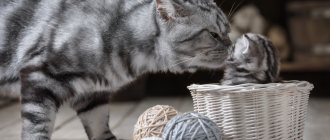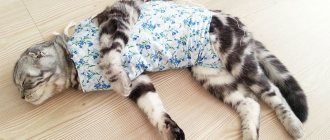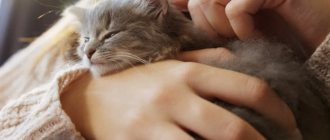A cat constantly licks its tail
If a cat often licks under its tail, this should alert the owner. Various reasons force males and females to lick this place.
If a cat often licks its tail, then this is:
- inflammation of the preputial sac;
- inflammation, injury or cancer of the foreskin;
- urethral diseases (stones, trauma, neoplasm);
- bladder diseases (infections, tumors, stones);
If a cat constantly licks itself, then this should alert the owner
- prostate diseases (prostatitis, tumor, abscess);
- urinary incontinence;
- dysfunction of the sphincter;
- bleeding (coagulopathy) and thrombocytopenia due to rat poison poisoning.
For your information! Cats have a fatty lubricant in their skin that contains cholesterol, which in the sun is converted into vitamin D. By licking, the cat distributes this substance over the entire surface of the body.
Females often lick themselves before and after childbirth, and this is not a pathology. But there are a number of situations where excessive licking is a symptom of illness.
If a cat constantly licks its tail, then this is:
- urinary tract infections;
- inflammation of the uterus and vaginitis;
- tumors of the genitourinary system;
- injury or foreign body in the urinary tract or vagina;
- blood clotting (coagulation) and thrombocytopenia in case of poisoning with rat poison;
- urinary incontinence, sphincter dysfunction;
- retained placenta or death of the kitten during childbirth.
Important! If a cat constantly licks the area near the tail, then the owner needs to pay attention to the discharge from the pet’s genitals. These symptoms will help the veterinarian make the correct diagnosis and treat your pet.
If your cat is constantly licking his tail, you need to take a closer look at other symptoms.
Allergic reactions to foods
The most common cause of itching and skin irritation in cats is food allergies. A cat can become ill from both natural food (for example, meat) and special industrial ones. Popular cheap foods (Kitecat, Whiskas, etc.) cause allergies in many people. It is advisable to choose premium hypoallergenic ones, which are sold only in pet stores.
For your information! Most often, allergies are caused by food proteins, which are found in large quantities in chicken meat, cow's milk and a number of other products.
If a veterinarian has discovered a food allergy in a cat, you need to exclude the dangerous product from the diet and prescribe the correct diet for your pet.
A cat food allergy often manifests itself as inflammation on the skin.
Presence of parasites in the body
External and internal parasites often cause cats to scratch and lick themselves. Fleas, ticks, and lice eaters are especially dangerous for furry pets. They bite the cat and drink its blood, and this leads to the development of allergies and decreased immunity. Ear mites often cause otitis media, a serious disease that can lead to serious complications.
If a cat has parasites in its fur, it will lick them frequently and feverishly. Small blood-sucking insects greatly irritate your pet's delicate skin. Parasites can be easily removed with flea treatment, but you should consult your veterinarian and check your cat for other diseases.
Flea dermatitis
Damage to the skin on the tail
Any owner knows why cats lick themselves. If your cat's tail has wounds or any other damage, it can cause itching and irritation. Having received an injury, the cat begins to lick the sore spot in order to heal it. This way the animals lick any sores. To prevent your cat from doing this, you can put an Elizabethan collar on it.
Unpleasant habit after castration
A situation often arises when a cat licks itself after castration. Every veterinarian knows what to do in this case. He must examine the pet and check for allergies, infections and inflammatory processes.
But is it possible for a cat to lick itself after castration, the answer will be clear - it’s impossible, because the pet can lick the post-operative suture and cause an infection. If the owner overlooked it, and after castration the cat licked a wound under its tail, this requires urgent treatment and re-suturing. To prevent this from happening, a medical collar is put on the cat, which must be worn for 10 days after the operation. The suture should be treated with special medications prescribed by a doctor.
Important! Sterilization is a necessary procedure, but it must be carried out strictly following the rules of hygiene and antiseptics.
After castration, the cat must be wearing an Elizabethan collar.
Why is overgrooming dangerous for cats?
Intense, frequent grooming can have serious consequences for a cat's health.
Main signs of overgrooming
:
- baldness, hairless areas, bald spots on the body;
- the presence of areas with sparse, brittle hairs;
- deterioration of coat condition;
- allergic manifestations;
- the presence of scratches, ulcers, long-healing wounds on the body;
- lethargy, apathy, or vice versa, constant anxiety.
Frequent licking can damage any areas of the dermis that the cat reaches with its tongue. Most often, damage is noticeable on the abdomen, the inside of the hind legs, on the front legs, sides, and sternum. The lesions are located symmetrically on the body.
By intensively licking the fur on its hind paw or tail, a cat can injure itself.
. If an infection enters the wound, it will lead to the development of acute inflammation in the deep structures of the dermis. In severe cases, if the cat gnaws the skin, necrotic lesions may appear in the damaged area.
When licking the fur, fleas and lice eaters enter the body, which carry viruses and bacteria. Overgrooming can cause disruption of the natural process of hair change, deterioration of the protective properties of the coat and dermis, which is especially dangerous for cats who walk along the street.
Reasons why a cat licks its fur in the absence of parasites
In many cases, a cat constantly licks itself not because of parasites, but for other reasons. The most common of them is stress. Compulsive licking in cats can be compared to the human habit of biting nails. This indicates that the cat is starting to get very nervous. The owner must eliminate the cause of the pet’s emotional distress.
The cat itches, but there are no fleas, it constantly licks itself
Other reasons why a cat constantly licks itself are fungal diseases (lichen), allergies, dermatitis, otitis, and inflammation. The doctor must make an accurate diagnosis and prescribe adequate treatment.
Lichen
Ringworm, or dermatophytosis, is a fungal infection of the skin and fur. The causative agents are fungi of the genus Microsporum or Trichophyton. They affect the roots of actively growing hairs. Characteristic bald patches appear on the head, tail, ears, and paws, and the skin peels off. In the affected areas, the hair can quickly fall out, and the cat begins to go bald.
This disease is very contagious, but is easily treated, does not pose a threat to the life of an animal or a person and does not lead to serious health consequences. Very often, cats with reduced immunity and small kittens get deprived of the disease. The main symptom of lichen is round bald spots covered with scales. If the disease is not treated, then over time the fungi will affect other areas of the coat.
Note! The itching associated with ringworm in cats is usually not severe. If it is accompanied by a skin disease of a bacterial nature, the itching may intensify. Then the cat will constantly itch and lick itself. Scars or scabs may form on the skin.
Ringworm in cats is diagnosed at a veterinary clinic. The doctor makes a hole with a Wood's lamp, takes a scraping from the skin, analyzes wool hairs and inoculates fungi on a nutrient medium. You will also need a blood test to check for infections. Once the diagnosis is confirmed, treatment should begin immediately.
For lichen, the course of treatment lasts a long time (about 3 weeks). In severe cases, recovery takes several months. The pet is prescribed medications for internal and external use. The veterinarian can prescribe medications such as microderm, vakderm, fungin, Yam BK ointment, etc. A sick pet must be isolated from other animals and provided with abundant and nutritious food, rich in vitamins and beneficial microelements. Despite the fact that people do not always become infected with shingles from a sick cat, it is necessary to thoroughly clean and disinfect the apartment.
Vaccinations against lichen are made with the Polivac TM or Vakderm-F vaccines. Vaccination is carried out twice with an interval of 2 weeks.
For your information! If the affected hair has stopped growing, it will not be affected by lichen. Therefore, cats often recover suddenly.
Ringworm in a cat
Dermatitis
Dermatitis refers to a whole group of inflammatory skin diseases in cats. Even a calm and affectionate animal becomes aggressive and restless. Reddened areas appear on your pet's skin, and sometimes a rash appears on them. The affected parts of the skin are very itchy and itchy, which is why the cat may often itch, lick, and even gnaw out fur and skin. Sore spots are hot to the touch. The kitten may meow loudly and lick its lips frequently. Then comes the next stage of the disease, when the skin peels off and becomes wrinkled. Purulent lesions may appear.
Causes of dermatitis in cats:
- allergies to food (preservatives and dyes);
- allergies to shampoos and other chemicals;
- infestation with fleas, lice eaters, ticks, worms and other parasites;
- burn or hypothermia;
- a scratch or bite on the skin;
- infection of already damaged skin by bacteria, development of inflammation;
- individual intolerance to certain drugs, especially oxytetracycline.
In most cases, the trigger for dermatitis is an allergy of any origin. Your cat may be allergic to dust, fungus, or food protein. If a cat's fur is brushed too vigorously, the skin may become damaged and dermatitis may occur.
Important! Dermatitis is dangerous because it often becomes chronic. Symptoms will come and go, and your cat's health will worsen. Deep, non-healing wounds may occur on the skin. Sometimes the cat licks itself and rubs the skin until it bleeds.
If you suspect dermatitis in a cat, you should not hesitate to contact a veterinarian. Only a doctor can find out the cause of the disease and prescribe treatment. First of all, you need to get rid of the allergen that triggered the development of dermatitis. To do this, you will have to replace food, shampoo and other household items. The veterinarian will help you choose the appropriate food.
Dermatitis in a cat
Endocrine system disorders
Excessive licking may be a sign of endocrine dysfunction in cats. The veterinarian performs many diagnostic tests to find out what exactly is causing these symptoms. Knowing the cause and mechanism of development of hormonal imbalance, the doctor will prescribe suitable treatment for your pet.
Otitis
Otitis is an inflammation of the middle ear in cats, often leading to dangerous complications. Pets suffer from otitis media much more often than people. If the cat begins to scratch its ear frequently and intensely and shakes its head, otitis may be suspected. The skin on the inside of the ear appears irritated, red and swollen. Treatment must be started immediately, otherwise purulent otitis may develop.
For your information! In the purulent form of the disease, a thick, dark brown liquid with an unpleasant odor is released from the ear. This disease causes severe pain to the cat. In severe cases, inflammation of the facial nerve may occur, then the pet's ear, eyelid or lip sag. Further inflammation affects the vestibular apparatus and brain. Because of this, the cat may die or remain disabled.
Otitis media in cats can be caused by parasites (especially fleas and ticks), bacteria, fungi, allergies, trauma, and foreign bodies in the ear. Hypothermia can also cause otitis media. Therefore, if the cat is cold or caught in the rain, it must be warmed up and kept in a warm room. Water that gets into the ears is very dangerous for your pet.
Diagnosis and treatment of otitis should only be carried out by a veterinarian. He will prescribe a course of treatment from a variety of drugs. Taking good care of a sick pet will keep it alive and healthy.
Otitis in a cat
Skin diseases
In addition to dermatitis of various origins, there are many other skin diseases of cats. Parasites can cause diseases such as demodicosis, scabies, and eczema. Ringworm and eosinophilic granuloma are especially widespread.
Dermatomycoses are a group of fungal diseases that affect the fur and skin of cats. Ringworm is a type of dermatomycosis. Treatment must be strictly under the supervision of a veterinarian.
Eosinophilic granuloma affects the lips and oral cavity. The disease manifests itself in the form of redness, swelling and hair loss at the site of the lesion. Pain and itching are rare, but the cat may lick the sore area frequently. The veterinarian diagnoses the disease and prescribes treatment. Eosinophilic granuloma is treated for a long time, but successfully and has a favorable outcome.
Skin diseases take a long time to cure
Important! Sometimes it happens that a cat licks its belly until it becomes bald. The reasons for this lie in severe stress, a fungal infection or skin parasites. If a cat licks itself a lot and begins to go bald, you need to take it to the veterinary clinic.
Bald patch on paw due to lichen
Ringworm and fungi
Ringworm in animals appears as small patches of baldness. In this case, scabs or erosion may be present on the skin, but this depends on the causative agent of the disease.
Quite often, the reason that an animal licks itself more often than usual is a fungal infection. It is impossible to identify the fungus without special equipment, but dry skin and flaking can help you suspect the disease. It is these symptoms that cause discomfort to the cat, in response to which he constantly licks himself, itches and chews his fur.
Upon careful examination, you will notice the following signs on the skin:
- Severe dryness;
- Change in color (pale skin or redness);
- Separation of dense grayish scales;
- Hair thinning;
These symptoms are characteristic of various fungal infections, including lichen. In this case, hair loss can be caused both by the characteristics of the disease and by the actions of the animal itself. Often, in response to itching, cats gnaw out islands of fur, trying to reach the skin with their claws.
Treatment of fungal infections is carried out with the help of antimycotic drugs. Shampoos and ointments used to treat people are usually prescribed - Nizoral, Ketoconazole, Clotrimazole.
We suggest that you familiarize yourself with Lameness in a cat, the main causes of the disease.
Diagnostic measures
How to stop a kitten from biting: reasons for this behavior
To correctly determine the reason why a cat licks itself too often, the veterinarian performs a number of diagnostic procedures. To diagnose lichen, a Wood's lamp is used. After this, the doctor takes scrapings from the sore spot and damaged hairs from the cat. Then the skin sample taken is inoculated onto a nutrient medium. Additionally, blood is taken from the cat to test for infections. All procedures together will help you find out the cause of the disease and heal your pet from the disease.
A cat's fur is examined with a Wood's lamp to diagnose lichen.
Prevention means
Only a specialist can cure dangerous licking of a cat’s fur.
To protect your pet from overgrooming, you should follow some simple rules for keeping cats:
- try to avoid stressful situations in your pet’s life, and if they arise, use homeopathic sedatives;
- carry out antiparasitic prevention in a timely manner;
- create the right diet and follow it;
- Monitor your pet's health and prevent illness.
Therapeutic measures
A cat hisses: the main causes of aggression
Any skin, parasitic or endocrine diseases should be treated immediately. The duration and method of treatment depends on the cause of the disease. If you have an allergy, you need to adjust your diet and remove the allergen. Ringworm is treated with antifungal ointments and tablets. For inflammatory and infectious diseases, a course of treatment with antibiotics and anti-inflammatory drugs is prescribed. Regardless of the cause of the disease, treatment always takes a long time: from 3 weeks to 2 months. It is necessary not only to help the cat stop itching, but also to completely eliminate the infection.
Treatment is prescribed depending on the cause of the disease
Symptomatic treatment
Active scratching is always just a symptom signaling that the animal is experiencing discomfort. Effective treatment without identifying the root cause is impossible. Therefore, the animal will still have to be taken to the veterinarian. Based on the external examination and test results, the specialist will prescribe treatment.
So, in case of allergic reactions, an antihistamine will be prescribed. It is important to identify the allergen and eliminate it from the animal’s life.
For dermatitis, otitis, pyoderma, the doctor will prescribe antibiotics. In some cases, hormonal therapy is used (mainly treating scratches with hormonal ointments and creams).
For fungal diseases, antifungal agents are prescribed.
Acaricidal drugs effectively control ticks.
The most important thing for a quick recovery is to avoid scratching. To do this, you can use special mittens on the animal’s paws. You can buy them at pet stores. If your cat takes off her mittens, you need to trim her claws short.
To prevent bites, a special collar is used.
If the cause of itching is parasites, then not only the animal is treated with the drug, but also the places where it is located in the apartment: couches, rugs, rugs, beds.
It is important to carry out treatment comprehensively. The diet needs to be enriched with vitamins and microelements. For these purposes, special vitamin complexes or dietary supplements are suitable.
Preventive actions
Fungal and bacterial infections can be prevented by practicing good hygiene. Special medications and treatments will help protect your cat from lichen, dermatitis, otitis media and other diseases. For prevention, you need to regularly treat your pet against fleas, ticks and fungi, and also wash the bowl and tray with disinfectants. Bathing with a special shampoo is beneficial for cats. This procedure only needs to be done once a year.
Important! After treating a kitten with anti-flea or anti-fungal products, the animal should not be bathed. It is forbidden to wet the area where the medicine was applied.
The cat licks itself to help itself
Sanitizing the tray and bowl
All items belonging to the cat - bowl, tray, toys, etc. - must be regularly washed and treated with disinfectants. This will protect your pet from infectious, fungal, viral and other diseases. The bowl can be washed with regular dishwashing detergent. Usually fungus does not form on a cat's bowl, most often in the tray. It is advisable to treat it with any antifungal spray against lichen. Additionally, you can treat the tray with camphor alcohol, which not only cleans and disinfects the surface, but also eliminates unpleasant odors.
The bowl and tray should be washed and disinfected regularly
Special flea products
There are many treatments available at pet stores for fleas and other external parasites. They are available in the form of drops on the withers, sprays and collars. It is advisable to treat the cat with drops on the withers; this is the most effective remedy. The room can be sprayed with flea spray. Flea collars are not very effective. It does not destroy insects, but only repels them. A collar can only be put on a cat if it has recently been treated for fleas. Flea drops such as Leopard, Frontline, Advantage, Inspector, and Bolfo spray are very effective.
Flea remedies










